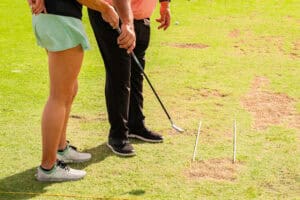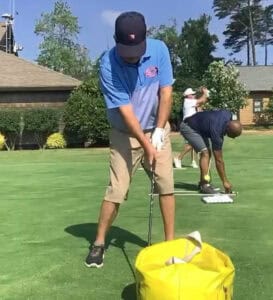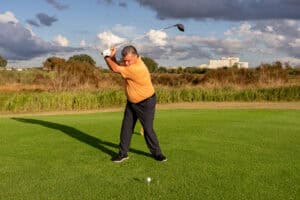How to Create a Golf Swing System That Works for You
Okay, you search for “golf academy Orlando” to find the best academy to visit during the Florida golf season. For you to “build a golf swing system” you can depend upon. You’ve been “inconsistent” and struggling with your swing. And recently you’ve felt as if your chasing something elusive in your game. You’re determined that your search for a golf academy in Orlando will put an end to your misery. And once and for all, “fix” your game.
Sounds all too familiar to me and my coaching staff at John Hughes Golf. Almost all our clients express this sentiments within the player profiles they complete prior to arrival for a full-day golf school program. For that matter, any of our golf skill improvement programs.
Every time you try to improve, it feels like you’re stepping into uncharted territory. You’re trying desperately not to compound errors in your swing. While at the same time make your golf swing from a “form” perspective as pretty and smooth as possible.
Sorry, it won’t happen! The reason? Attempting to build a “perfect” golf swing based on a universal system is a myth. No two golfers are alike. Therefore, no two golf swings are alike. A “one size fits all golf swing system” does not work for everyone. What may work for your best golfing buddy, who scores in the mid-80’s, may never work for you.
Here’s the truth. Your golf swing doesn’t need to look like Tiger Woods’ or Jack Nicklaus.’ It just needs to work for you! And when coming to a golf school. Or participating in a golf skill improvement program, that should always be the goal.
Building a Golf Swing is More Than Physical
The phrase “how to create a golf swing system that works for you” is more than just a catchphrase. It’s a mindset. Your swing should reflect your body’s unique mechanics, strengths, and limitations. As well as how you uniquely strategize your way around a golf course. Your goal should never be to replicate someone else’s golf swing or on-course strategy. Why, because you never own the body or brain you’re attempting to mimic. Nor their exact length or accuracy with every shot they take.
Your goal as a golfer, no matter the experience or skill level, is to understand the fundamentals that apply to you and develop a swing that maximizes your potential. Understanding how the unique shape and strength of your body can set up in a way that makes your golf swing more efficient. As well as understanding your personality and your determination level. To make the best decisions possible about each swing you attempt.
At John Hughes Golf, here’s how we start you on the journey of finding a system of decisions and in turn movements that can work most efficiently and specifically for you.
Understand Your Strengths and Limitations
Before you start making drastic changes to your golf swing, take a step back and assess your body. A proper swing is influenced by your flexibility, mobility, and athleticism. For example, if you have tight hips or limited shoulder rotation, try to imitate a full-body rotation swing like Rory McIlroy’s could backfire.

Realize that most recreational golfers are sitting, most of every day. Whether it be at a computer, behind the wheel of a vehicle, at a table eating, or just chatting with friends or coworkers, sitting is not always the best thing your body can be doing. Particularly if you’re looking to play better golf.
Your ability to “disassociate,” or separate your upper body from your lower body is the main ingredient to a better golf swing. For that matter, it’s the main ingredient for you to be active in life. Here is a simple exercise you can use to determine how much you can separate your lower body from your upper body when making a golf swing.
Drill: The Body Rotation Check
- Stand tall with your feet about shoulder-width apart.
- Cross your arms over your chest and rotate your upper body, without rotating your lower body. How far can you rotate without moving your lower body?
- Now do the same, but leave your shoulders and upper body motionless, as you rotate your core. Do not use your knees to rotate your core. How far can you rotate your lower body without rotating your upper?
- Take note of any areas that feel restricted or uncomfortable.
By assessing where your body feels stiff, you can determine what areas of your swing need modification. For example, if your shoulders are tight, focusing on drills that increase shoulder mobility, like doorway stretches or resistance band pulls, could help you create a more fluid motion. Working with a fitness coach or a golf pro who understands body mechanics can help tailor a program specific to your body type.
Focus on Fundamentals, Not the “Perfect” Golf Swing
You don’t have to be athletic to create a great set-up position. Every golfer can do so with minimal effort.
Trying to mimic another golfer’s swing can lead to frustration. Especially if your body type or natural swing tendencies are different. The key is to build your own fundamental system that’s both functional and repeatable. Once you’ve addressed any stability, mobility, or flexibility limitations, it’s time to focus on some core principles.
Everyone’s fundamental set up positions can be categorized by the items listed below. However, everyone’s actual set up positions will differ as compared to others due to your body being different from everyone else’s.
For instance, at what degree do your hands hang at an angle to your body when taking your address position while allowing your arms to hang freely from your shoulders? I call this “natural arm hang” and everyone has a different angle at which their hands hang. Why is this important? It is your natural arm hang that determines the position of your hands-on the handle of the golf club that produces your “neutral” position. As compared to a strong or weak grip position.
This is only one example of how we are all different. Yet, we can all fit into the categories below to set up in a fundamentally sound position to maximize the efficiency of your golf swing. The Key Fundamentals of Set up that will allow you to build a solid and consistent swing system for you are:
- Aim and Alignment: As discussed within many times in past blogs and various videos I’ve produced, you must aim the club first to your target! Using the leading edge of the club to create a 90° angle with your intended target line. When this happens first in your set up routine, your feet, knees, hips, and shoulders will automatically align parallel to your intended target line. Unless you have physical deficiencies preventing you from doing so. Misaiming and in turn misaligning always leads to

A stable drill within all John Hughes Golf programs is the use of alingment sticks to assist with proper aim of the club. It also assists with other important parts of your set up position.
compensatory movements in the swing. - Balance and Posture: Without great balance, you can’t have great posture. Your feet should feel equal weight distribution from toe to heel. While from the belt down, each side of your lower body is supporting 50% of your weight. Doing so, you can create a spine angle and knee flex that will feel more comfortable and appropriate for your body type. No matter if your tall or short, thin or round.
- Ball Position: Ball position can affect how you balance. As well as the low point of your swing. Be sure to understand the proper ball position for each club you use, related to the low point of your swing.
- Grip: This is where every swing begins. A good grip should feel comfortable and secure. While allowing for natural wrist action through impact. An overly tight grip can lead to tension, while a loose grip can cause the clubface to be unstable.
Drill: The Alignment Stick Drill
- Place alignment sticks or clubs on the ground, one along your target line and the other parallel to it, aligning with your feet, hips, and shoulders.
- Practice your swing by focusing on maintaining proper alignment. To do so, always hit the ball from between the 2 alignment sticks. This helps to develop consistency in your swing’s path, eliminating erratic shots that often stem from poor posture or alignment.
- Add a third alignment stick at a 90° angle outside of the target alignment stick to assist with seeing proper ball position.
By honing your basic set up positions, and repeating those positions in a manner that creates a standard set up for you, you can develop a golf swing system that remains adaptable but also dependable. You’ll also have a standard from which you can vary from, based upon the situation and lie your next shot is in.
Develop a Repeatable Tempo
One of the most frustrating things in golf is hitting some shots with ease. And others with complete unpredictability. Does this happen to you often? If so, could be your tempo or rhythm isn’t consistent. Or in sync.
A good golf swing system isn’t necessarily fast or slow. It’s repeatable. You don’t need to swing with speed to be effective. Think of a swing that flows with smoothness and rhythm instead of trying to hit the ball as hard as possible. A good example of this is mentioned in a previous blog about me swinging to 2 different songs when I played my best. The songs hummed in my head provided the repeatable rhythm my body needed to synchronize my swing. As well as keeping my mind from thinking about too many swing thoughts.
Most golfers find out the hard way that you don’t have to swing hard to hit it far. When swinging at less than 100% while performing a drill designed to get the ball into the middle of the club face at impact, most golfer finally have that epiphany. The ball is compressed in the sweat spot of the face. Producing a lower trajectory with more ball speed than they are accustomed to. Resulting in a straighter ball flight that flies further.
Here is a simplified version of humming a song in your head that you should try at the practice facility before implementing it on the course.
Drill: The Counting Drill
- As you take your backswing, count “1” in your head.
- As you transition into the downswing, count “2.”
- Focus on keeping the transition from backswing to downswing as smooth and consistent as possible.
- The goal is to keep your rhythm in sync, not speeding up or slowing down between motions.
Find a Comfortable Ball Flight Path
One of the most crucial elements of creating a golf swing system that works for you is understanding your natural ball flight tendencies. Even more importantly, accepting and embracing a consistent ball flight provides you with the best chance to create lower scores.
Every player has a natural draw or fade. Fighting against that on the course will lead to frustration and blow-up holes. Attempting to fix a swing while playing is a mortal sin on the course. Even worse is not accepting and using that swing to your advantage. Embracing your natural tendencies on the course is something the touring professionals do on a daily, if not hole by hole basis. Without doing so, they’re ordinary golfers, just like you.
Working to refine and control your natural ball flight should take place at the practice facility. Providing you with ample time and reps to rein in the bigger mishaps and understand your tendencies. An example of this is if you naturally hit a draw (right-to-left ball flight), and your attempting hit fades on the course, you’ll experience inconsistency. Instead, focus on dialing in your draw when practicing. Tightening the shape. Or controlling the distance. Similarly, if you have a fade (left-to-right ball flight), reduce its size to avoid overcompensating.
Drill: The Flight Path Drill

- Set up two alignment sticks on the ground: one along the target line and one pointing slightly to the left (for a fade) or to the right (for a draw).
- Take practice swings with the goal of matching your ball flight in the direction of the alignment stick. Over time, you’ll be able to hone your natural ball flight and develop a swing that maximizes it.
Focus on Impact, Not Just the Golf Swing
A major part of developing a golf swing system that works for you is learning how to make solid contact with the ball. It’s all about impact!
Whether you believe this or not, it’s the truth. You don’t have enough time in a day, a week, a month, or even a year, to be overly concerned about your back swing. Touring professionals work countless hours daily to make the smallest of adjustments to their swings. Due to other life priorities that keep you busy doing other things, you just don’t have the time touring professionals have to worry that much about your back swing.
If you took half the time you spend worrying and working on your back swing and used it to improve your impact positions, you’d be the better golfer for it. Impact is the moment of truth! When everything in your swing comes together. Regardless of your swing style or body type, a good impact position is crucial for consistency.
Drill: The Impact Bag Drill

- Set up an impact bag or a large pillow in front of you (at the center of your stance).
- Take slow swings, focusing on making solid contact with the bag at the point where your hands are ahead of the ball (for a slightly forward shaft lean).
- This drill helps you develop a proper, consistent impact position that leads to better distance and control.
Work with a Pro to Fine-Tune Your System
Even though you’re creating a swing system that works for you, it’s still important to get professional feedback. The team of highly trained golf coaches of John Hughes Golf can assess your skills and swing mechanics and suggest minor adjustments to improve efficiency. We can also help ensure that your system stays fluid and adaptable as you progress.
Conclusion
At the end of the day, the phrase “How to create a golf swing system that works for you” is about finding your personal approach to the game. It’s not about trying to match the pros, but about creating a foundation that helps you achieve more consistent, repeatable results.
Focus on your body’s strengths, simplify your golf swing, and most importantly, make sure you’re building a system that you can rely on under pressure. And accept the fact that what you can produce in your swing could work for you if you allow it to. And set up for it.
By consistently working on your posture, alignment, tempo, and ball flight tendencies, you’ll gradually eliminate the need to “fix” your golf swing. Instead, you’ll have a system that works—not just for today, but for every round you play.
If you’d like to create a golf swing system that works for you, please contact John Hughes Golf to schedule a skills assessment or other coaching program.







